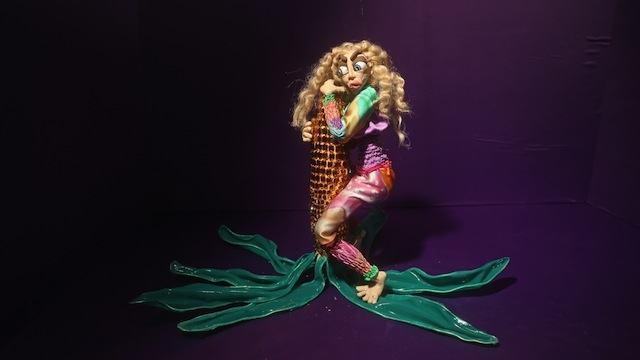Lisson Gallery, London, 31 March – 6 May
Cavorting acorns, misanthropic bananas, mischievous elephants, salacious poos and bashful ponies are just some of the objects-turned-characters making up the floor-based tableau that crowds the first of two rooms in Nathalie Djurberg and Hans Berg’s exhibition. At first resembling children’s toys, these silicone figures – which also include seedy carrots, angry anthropomorphised houses and vulgar golf-ball/moon-like beings – molest, grope, tease and taunt one another; pulling down pants and socks, peeling, licking, prodding and straddling. Three record players amidst the pandemonium emit – from their speakers – semisexy moans, sobs, sighs and groans, while scattered speech bubbles, scrawled on card, reveal worried or ashamed proclamations such as ‘what crap is buried here?’ or ‘this is not going as well as it did when I was thinking about it’. The whole scene is debauched yet humorous – Hieronymus Bosch meets Roald Dahl, maybe? – and is characteristic of Djurberg and Berg’s work to date, in which the would-be innocence of cutesy puppets mutates towards a series of grotesque or sardonic allegories for human taboo.
In the adjacent room, three videos – almost cinematised fables – feature many of the same figures, animated via stop-motion, as they explore various primal emotions from lust to envy, gluttony to humiliation. Dark Side of the Moon (2017) takes place in a shadowy wood populated by a talking house, a smoking wolf, a young girl (Little Red Riding Hood?), an overweight pig and a prancing golf ball/ moon. An atmosphere of curiosity, indulgence and vulnerability creeps into the story as the group discuss (via speech bubbles) ideas around greed, shame and loss of innocence, accompanied by an ominous, though fanciful, wind-instrument score.
Delights of an Undirected Mind (2016) describes a sort of coming-of-age dreamscape in which a young girl falls asleep and imagines a depraved bedroom tea-party featuring an undressing elephant, a wolf in a nightgown, a sad rabbit, a tiger dressed as a baby who drinks milk straight from a cow’s udder, a leering octopus, some cheese guiltily canoodling with a mouse, the same mouse riding a hotdog like a motorbike, a seductive fox wearing furs, a fat crocodile opening gifts, a bull in a matador costume. These characters appear and reappear one by one, as a soundtrack of percussive beats and eerie chanting drives the chaos forward.
Finally, Worship (2016), the most explicit of the three works, explores the stereotypes and imagery associated with porn and sexual fetishisation. The eight-minute video presents a pageant of silicone women and men, dressed in sequins, velour or silk, who perform different erotic acts: grinding against a giant banana, squeezing a pink inflatable doughnut, twerking with a Siamese cat, writhing with a giant sequined fish or a giant sequined ice-lolly or a gold and black motorbike or an aubergine on wheels… These figures strip, touch themselves and attempt to seduce the viewer, as a dark electro-pop score provides them with a rhythm to which to move.
Morality is missing, to varying degrees, across these works, which feel like an adventure within human nature’s most capricious and animalistic impulses. The creeping, climactic structure of the videos and the unapologetic transgressions of the exhibition’s opening tableau make us very aware of our own desires. But when coupled with the homemade style of the figures, the works manage to retain a sense of humanity. And while the characters might commit vulgar or sadistic acts, their violence is often presented alongside shame, and their cruelty coexists with the material tenderness of their making. Thereby asking us to provide a level of compassion, or even knowing complicity, to/with their actions – and thus reaffirming the very morality that is so lacking to begin with.
From the Summer 2017 issue of Artreview
